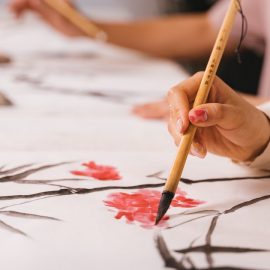

This article is an excerpt from the Shortform book guide to "The Talent Code" by Daniel Coyle. Shortform has the world's best summaries and analyses of books you should be reading.
Like this article? Sign up for a free trial here.
What are some effective coaching techniques? Why is motivational coaching important?
In The Talent Code, Daniel Coyle says that coaching others can help them cultivate talent. He explores five techniques that effective, talent-building coaches use to motivate their students.
Let’s dive deeper into these effective coaching techniques.
Technique 1: Use Motivational Language
Coyle explains that there’s a certain effective coaching technique that great coaches use that motivates someone to work harder and achieve more. He says that high praise like, “You’re the greatest” isn’t as effective as motivational comments that speak to hard work, effort, or perseverance—for example, “Good job,” or, “Your work is really paying off.”
This type of language motivates a student to practice and challenge themselves because it emphasizes that you value their work, not their natural skill. This helps students understand the reality of how talent is grown and motivates them to continue working at it when things get difficult—rather than giving into the defeated feeling that they just weren’t born with the necessary skills.
Motivate a Growth Mindset
In Mindset, psychologist Carol S. Dweck notes that children who are praised for being smart tend to shy away from difficult tasks because they fear failure—which threatens their identity as smart people. This reaction comes from a fixed mindset, a belief that innate abilities (like intelligence) are unchangeable. By contrast, children who are praised for their effort develop a growth mindset, a belief that you can build upon your natural abilities by working hard and challenging yourself.
In The Power of Moments, Chip and Dan Heath offer guidelines on how to coach someone through a challenge in a way that helps them avoid the fear of failure and cultivate a growth mindset:
- Express high expectations and confidence: By being demanding yet reassuring, you help your student become more comfortable with challenging goals while bolstering their confidence in their ability to stretch themselves.
- Give direction: By giving your student a specific high-challenge project, you prevent them from defaulting to a project that seems easier or carries a lower risk of failure.
- Assure support: Assuring your student of your support expresses to her that it’s okay to ask for your help—she doesn’t need to fear what you’ll think of her if she fails or can’t accomplish the goal alone.
Technique 2: Use an Engaging, Theatrical Personality
Coyle found that coaches who use engaging, theatrical personalities are able to connect with their students more. Their dramatic performance engages the student and makes them more interested in learning. Coyle says that this is an especially effective technique when you have to give hard, honest feedback. The student has bought into the fun, over-the-top spectacle—making the criticism part of a playful drama and easier for them to receive without defensiveness.
(Shortform note: People may not always take feedback well, but it’s a crucial part of building skill. In Thanks for the Feedback, Douglas Stone and Sheila Heen argue that people can only achieve success by accepting and incorporating other peoples’ criticisms and direction—this is why it’s so important to use an approach that students are receptive to. This helps your student feel safe and avoid the emotional triggers that might compel them to ignore feedback they don’t like.)
Technique 3: Communicate Information Precisely and Succinctly
Through his research, Coyle found that coaches who are masters of meaningful practice often give exacting advice in short sentences, right when it is needed—for example, “More vibrato,” “Lean into it,” or “Shoot now.”
(Shortform note: This technique may seem contradictory to Technique 2, but Coyle clarifies that succinct feedback is a useful coaching technique while the student is performing. On the other hand, theatrical feedback should take place before or after the performance.)
This type of succinct communication allows the coach to give large amounts of targeted feedback in a short period of time, condensing as much skill-building into one practice session as possible. It’s also effective because these real-time directions allow the student to notice and correct their mistakes right away.
(Shortform note: While this technique is useful for helping students realize and correct their mistakes right away, it’s important to give them succinct positive feedback, as well—this will communicate to them precisely what they should repeat or be doing more of.)
Technique 4: Develop Skill-Specific Training
Coyle explains that different skills require the building of specific types of neural circuits. Some skills, like soccer or improv comedy, are flexible circuit skills that require improvisation and the ability to react and make decisions in different contexts. Consistent circuit skills, like figure skating or playing the violin, require precise movement, focus, and consistency of precision.
Great coaches are able to identify which circuits their students need to fire and can design lessons, practice sessions, or teaching methods that will fire the correct circuits to get their students into the development zone necessary for the skill they’re focused on.
For example, an acting coach might design an improv comedy class to develop flexible circuit skills by demanding quick reactions in rapid succession. A violin teacher might help their student master a concerto by developing consistent circuit skills, demanding the same perfect tone on each note, every time.
(Shortform note: Even if someone knows their skill well—and is knowledgeable about the training they need to continue improving—they will need a coach to continue growing. This is because it’s difficult for them to put themselves in demanding situations. A coach can push them into challenging situations that will effectively improve their skills and support them in setbacks.)
Technique 5: Personalize Guidance to the Student
The last effective coaching technique is to personalize guidance to the student. Coyle asserts that coaching isn’t a one-size-fits-all endeavor—rather, excellent coaches consider the best way to tailor their guidance to the needs of each student. They identify a student’s current skill set, pinpoint the skills that need improvement, and find the most effective way to flag and correct their mistakes.
Additionally, many excellent coaches—particularly those involved in early-childhood learning—spark the impassioned motivation that will carry the student through years of meaningful practice by working to identify the best way to hook a student into loving the learning process. For example, one student may be motivated by the chance to display her paintings in her school’s art show, whereas another student is more motivated by the idea of qualifying for an after-school drawing class.

———End of Preview———
Like what you just read? Read the rest of the world's best book summary and analysis of Daniel Coyle's "The Talent Code" at Shortform.
Here's what you'll find in our full The Talent Code summary:
- A deep dive into where great talent comes from
- The key elements of the type of practice you need to develop talent
- Why it's never too late for greatness, if you know how to grow it






